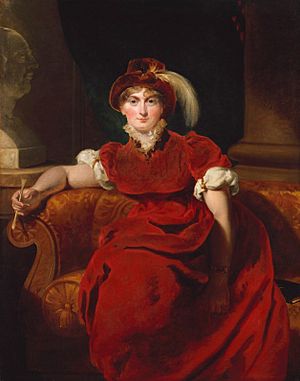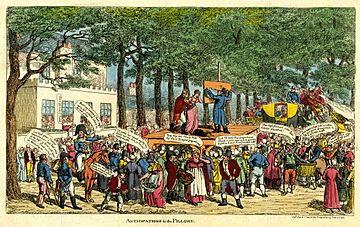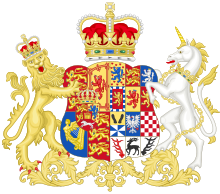Caroline of Brunswick facts for kids
Quick facts for kids Caroline of Brunswick |
|||||
|---|---|---|---|---|---|
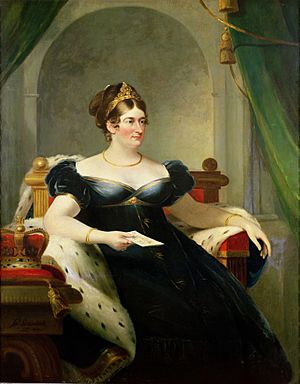
Portrait by James Lonsdale, 1820
|
|||||
| Queen consort of the United Kingdom and Hanover | |||||
| Tenure | 29 January 1820 – 7 August 1821 | ||||
| Born | 17 May 1768 Brunswick, Brunswick-Wolfenbüttel, Holy Roman Empire |
||||
| Died | 7 August 1821 (aged 53) Hammersmith, Middlesex, England |
||||
| Burial | 25 August 1821 Brunswick Cathedral |
||||
| Spouse | |||||
| Issue | Princess Charlotte of Wales | ||||
|
|||||
| House | Brunswick-Bevern | ||||
| Father | Charles William Ferdinand, Duke of Brunswick | ||||
| Mother | Princess Augusta of Great Britain | ||||
Caroline of Brunswick-Wolfenbüttel (born Caroline Amelia Elizabeth; 17 May 1768 – 7 August 1821) was a queen. She was the Queen consort of the United Kingdom and Hanover. Her time as queen was from January 29, 1820, until her death in 1821. She was the wife of King George IV, but they lived separately. Before becoming queen, she was the Princess of Wales from 1795 to 1820.
Caroline was the daughter of Charles William Ferdinand, Duke of Brunswick. Her mother was Princess Augusta of Great Britain. In 1794, Caroline was engaged to her cousin, George, the Prince of Wales. They had never met before. George had already secretly married Maria Fitzherbert.
Caroline and George married in 1795. But they separated soon after their only child, Princess Charlotte, was born in 1796. By 1806, there were rumours about Caroline's private life. An investigation was started. The leaders of the investigation found "no foundation" for the rumours. However, Caroline's visits with her daughter were still limited.
In 1814, Caroline moved to Italy. There, she hired Bartolomeo Pergami as a servant. Pergami quickly became her closest friend. Many people thought they were in a close relationship. In 1817, Caroline was very sad when Charlotte died during childbirth. She heard the news from a messenger. George had refused to tell her himself. He was determined to end his marriage to Caroline.
In January 1820, George became King of the United Kingdom. Caroline then became queen. George wanted to end their marriage, but Caroline refused. Ending a royal marriage was very difficult. Caroline returned to Britain to claim her place as queen. The British people loved her. They felt sorry for her and disliked the new king. George tried to end their marriage through a law called the Pains and Penalties Bill 1820. But George and the bill were very unpopular. Caroline was so popular that the bill was stopped. The King did not allow Caroline to attend his coronation in July 1821. She became ill in London and died three weeks later. Her funeral procession went through London. She was buried in her home country, Braunschweig.
Contents
Early Life of Caroline
Caroline was born a princess in Braunschweig, Germany. This city is also known as Brunswick in English. She was born on May 17, 1768. Her full title was Duchess of Brunswick-Wolfenbüttel. Her father was Charles William Ferdinand, Duke of Brunswick. Her mother was Princess Augusta of Great Britain. Princess Augusta was the older sister of King George III.
Caroline was taught by governesses. Music was the only subject where she received advanced lessons. From 1783 to 1791, Countess Eleonore von Münster was her governess. The Countess cared for Caroline. But she could not teach Caroline to spell well. Caroline preferred to tell a secretary what to write. Caroline could understand English and French. However, her father admitted she needed more education.
Caroline's mother was British. She said that all German princesses learned English. This was in case they were chosen to marry George, Prince of Wales. He was George III's oldest son and heir. He was also Caroline's first cousin.
John Stanley saw Caroline in 1781. He later became the 1st Baron Stanley of Alderley. He wrote that she was a pretty girl with curly, fair hair. In 1784, she was called a beauty. Two years later, Honoré Gabriel Riqueti, comte de Mirabeau described her. He said she was "most amiable, lively, playful, witty and handsome."
Caroline grew up with very little contact with men. This was strict even for her time. She was always watched by her governess and older ladies. She was kept in her room when her family had guests. She was told to stay away from windows. She was usually not allowed to go to balls or court events. When she was allowed, she was forbidden to dance.
A rare exception was her older brother's wedding. This was Charles's wedding. She was finally allowed to dance. But only with the groom and her new brother-in-law. This was the Prince of Orange. She was still not allowed to eat alone with her brother.
Her isolated life bothered her greatly. One time, she was again banned from a ball. She pretended to be very sick. Her parents left the ball to see her. When they arrived, she claimed she was having a baby. She made them send for a midwife. When the midwife arrived, she stopped pretending. She asked her mother, "Now, Madam, will you keep me another time from a ball?"
Her mother wanted one of her children to marry into her English family. In June 1781, her nephew Prince Frederick, Duke of York and Albany visited Brunswick. Her mother was sad that Caroline could not be there often. Caroline received many marriage proposals from 1782 onwards. Marriage was suggested with the Prince of Orange and Prince George of Hesse-Darmstadt. Also with Charles, Duke of Mecklenburg-Strelitz. And the second son of the Margrave of Baden. Her mother wanted an English prince. Her father wanted a Prussian prince. But none of these marriages happened. Caroline later said her father stopped her from marrying a man she loved. This was because he was not high-ranking. It is not clear who this man was. But people at the time spoke of an officer. He was called the "Handsome Irishman" and lived in Brunswick. Caroline was said to be in love with him. There was also a rumour that Caroline had a child when she was fifteen.
She was not allowed to socialize with men. But she was allowed to ride horses. During her rides, she visited the homes of local farmers. She had done this as a child. She met children to play with then. As an adult, one of these visits supposedly led to a pregnancy. There is no proof of this rumour. But it was well known during her life. It was mentioned as a reason why she married later than usual. This was despite her being considered good-looking. And despite receiving many marriage proposals.
Engagement to George
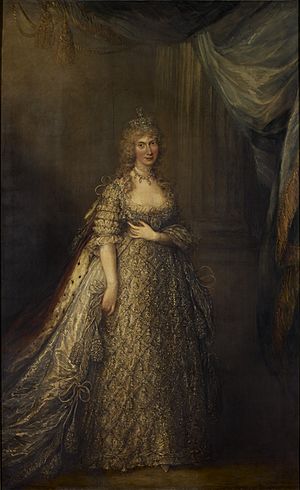
In 1794, Caroline and the Prince of Wales became engaged. They had never met. George agreed to marry her because he owed a lot of money. If he married a suitable princess, Parliament would give him more money. Caroline seemed like a good choice. She was a Protestant and from a royal family. The marriage would also connect Brunswick and Britain. Brunswick was a small country. But Britain was at war with revolutionary France. So, Britain wanted allies in Europe. Brunswick was ruled by Caroline's father. He was a respected soldier, Charles William Ferdinand, Duke of Brunswick. He had married Princess Augusta of Great Britain, King George III's sister.
On November 20, 1794, Lord Malmesbury arrived in Brunswick. He was there to take Caroline to her new life in Britain. In his diary, Malmesbury wrote his concerns about Caroline. He felt she was not suitable for the prince. He thought she lacked good judgment and manners. She spoke her mind too easily and acted carelessly. She also often forgot to wash or change her dirty clothes. He wrote that she had "some natural but no acquired morality." She also had "no strong innate notions of its value and necessity." However, Malmesbury was impressed by her courage. On the way to England, they heard cannon fire. They were close to the French army. Caroline's mother was with them. She was worried for their safety. But Caroline was calm.
On March 28, 1795, Caroline and Malmesbury left Cuxhaven. They sailed on the ship Jupiter. Bad weather delayed them. They landed a week later, on April 5, at Greenwich. There, she met Frances Villiers, Countess of Jersey. Lady Jersey was George's close friend. She had been chosen as Caroline's Lady of the Bedchamber.
When George met Caroline for the first time, he asked for a glass of brandy. He was clearly disappointed. Caroline also told Malmesbury that the Prince was "very fat." She added, "he's nothing like as handsome as his portrait." At dinner that evening, the Prince was upset by Caroline's talkative nature. He also disliked her jokes about Lady Jersey. Caroline was sad and disappointed. George clearly preferred Lady Jersey over her.
A Difficult Marriage
Caroline and George married on April 8, 1795. The wedding was at the Chapel Royal, St. James's Palace, in London. George thought Caroline was not attractive and not clean. He had already secretly married Maria Fitzherbert. But his marriage to Fitzherbert was not legal. This was because of the Royal Marriages Act 1772.
Nine months after the wedding, Caroline gave birth to Princess Charlotte. She was born at Carlton House on January 7, 1796. Charlotte was George's only legal child. She was second in line to the British throne after her father. Just three days after Charlotte's birth, George made a new will. He left all his property to "Maria Fitzherbert, my wife." To Caroline, he left only one shilling.
Rumours about Caroline and George's difficult marriage were already spreading. Newspapers claimed that Lady Jersey opened and shared Caroline's private letters. Caroline disliked Lady Jersey very much. She could not visit or travel anywhere without George's permission. The newspapers criticized George for spending too much money. This was during a time of war. They showed Caroline as a wronged wife. People cheered her in public. They praised her friendly and open nature. George was upset by her popularity and his own unpopularity. He felt stuck in a marriage without love. He wanted to separate.
In April 1796, George wrote to Caroline. He said, "We have unfortunately been oblig'd to acknowledge to each other that we cannot find happiness in our union. ... Let me therefore beg you to make the best of a situation unfortunate for us both." In June, Lady Jersey left her role as Caroline's Lady of the Bedchamber. George and Caroline were already living apart. In August 1797, Caroline moved to a private home. This was The Vicarage or Old Rectory in Charlton, London. Later, she moved to Montagu House in Blackheath. She was no longer controlled by her husband. She could entertain anyone she wished. She was friendly with Admiral Sir Sidney Smith and Captain Thomas Manby. She may have had a short friendship with the politician George Canning.
The Delicate Investigation
Princess Charlotte was cared for by a governess. She lived in a large house near Montagu House in the summers. Caroline visited her often. It seems that one daughter was not enough for Caroline's motherly feelings. She adopted eight or nine poor children. These children were placed with families in the area. In 1802, she adopted a three-month-old boy, William Austin. She brought him into her home. By 1805, Caroline had problems with her neighbors. They were Sir John and Lady Douglas. They claimed Caroline had sent them troubling letters. Lady Douglas also claimed that William Austin was Caroline's son.
In 1806, a secret group was formed. It was called the "Delicate Investigation." Its job was to look into Lady Douglas's claims. The group included four very important men. They were Prime Minister Lord Grenville. Also, the Lord Chancellor Lord Erskine. And the Lord Chief Justice of England and Wales Lord Ellenborough. And the Home Secretary Lord Spencer. Lady Douglas said that Caroline had told her in 1802 that she was pregnant. She also claimed Austin was her son. Lady Douglas also said Caroline had spoken badly about the royal family. Caroline's servants could not confirm she had been pregnant. They said the child was brought to Caroline's house by his real mother, Sophia Austin. Sophia was called to speak to the group. She said the child was hers.
The group decided there was "no foundation" for the claims. But even though it was supposed to be secret, gossip spread. News of the investigation got out to the public. Later that year, Caroline received more bad news. Brunswick was taken over by the French. Her father was killed in the battle of Jena-Auerstadt. Her mother and brother, Frederick William, Duke of Brunswick-Wolfenbüttel, fled to England. Caroline had wanted to go back to Brunswick. But much of Europe was controlled by the French. She had no safe place to go.
During the Delicate Investigation, Caroline was not allowed to see her daughter. Afterward, her visits were limited to once a week. She could only see Charlotte when Caroline's own mother was present. Meetings happened at Blackheath or an apartment in Kensington Palace. This apartment was set aside for Caroline's use.
Living Apart
By the end of 1811, King George III was permanently ill. The Prince of Wales was made Regent. This meant he ruled in his father's place. He further limited Caroline's visits with Princess Charlotte. Caroline became more isolated from society. Many high-society people chose to go to George's parties instead of hers. She moved her London home to Connaught House in Bayswater. Caroline needed a strong helper. She wanted someone to help her fight George's control over her daughter. She teamed up with Henry Brougham. He was an ambitious politician who wanted changes. They started a campaign against George. George fought back by sharing Lady Douglas's statements from the "Delicate Investigation." Brougham responded by sharing the statements of the servants and Mrs. Austin. Charlotte supported her mother. Most of the public did too. Jane Austen wrote about Caroline: "Poor woman, I shall support her as long as I can, because she is a Woman and because I hate her Husband."
In 1814, after Napoleon's defeat, important people from all over Europe came to London. They came for celebrations. But Caroline was not invited. George's relationship with his daughter was also getting worse. Charlotte wanted more freedom from her father's strict rules. On July 12, George told Charlotte she would be kept at Cranbourne Lodge, Windsor. Her staff would be changed. She could have no visitors except her grandmother, Queen Charlotte, once a week. Charlotte was horrified. She ran away to her mother's house in Bayswater. After a worried night, Brougham convinced Charlotte to return to her father. Legally, she could be placed in her father's care. There was also a risk of public unrest against George. This might harm Charlotte's position if she kept disobeying him.
Caroline was unhappy with her situation in Britain. She made a deal with the Foreign Secretary, Lord Castlereagh. She agreed to leave the country. In return, she would get £35,000 each year. Both Brougham and Charlotte were upset by Caroline's choice. They knew that Caroline's absence would make George stronger. It would make them weaker. On August 8, 1814, Caroline left Britain.
Life in Exile
After a two-week visit to Brunswick, Caroline traveled through Switzerland to Italy. Along the way, possibly in Milan, she hired Bartolomeo Pergami as a servant. Pergami quickly became the head of Caroline's household. He also arranged for his sister, Angelica, Countess of Oldi, to become Caroline's lady-in-waiting. In mid-1815, Caroline bought a house. It was Villa d'Este, on the shores of Lake Como. This was despite her money problems.
From early 1816, she and Pergami went on a trip around the Mediterranean Sea. They visited Napoleon's old palace on Elba. They also visited Sicily. There, Pergami received the Order of Malta and a barony. By this time, Caroline and Pergami were openly eating meals together. Many people believed they were in a close relationship. They visited Tunis, Malta, Milos, Athens, Corinth, Constantinople, and Nazareth. Caroline entered Jerusalem riding a donkey. She was part of a group with camels. Pergami was made a Knight of the Order of Saint Lazarus. Caroline created her own award, the Order of Saint Caroline. She named Pergami its Grand Master. In August, they returned to Italy. They stopped in Rome to visit Pope Pius VII.
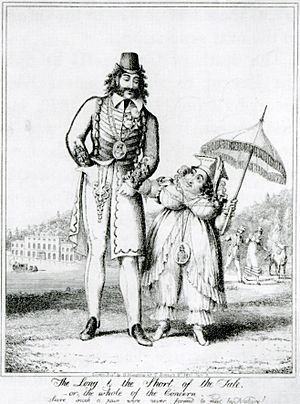
By August 1817, Caroline's debts were growing. So, she sold Villa d'Este. She moved to the smaller Villa Caprile near Pesaro. Pergami's mother, brother, and daughter joined Caroline's household. His wife did not.
The year before, Caroline's daughter, Princess Charlotte, had married Prince Leopold of Saxe-Coburg-Saalfeld. The future of the British monarchy looked bright. Then, a sad event happened. In November 1817, Charlotte died after giving birth to a stillborn son. Charlotte had been very popular with the public. Her death was a great loss for the country. George refused to write to Caroline to tell her. He left it for their son-in-law Leopold to do. But Leopold was deep in sadness and delayed writing. George did write to the pope about the tragedy. By chance, the messenger carrying the letter passed by Pesaro. That is how Caroline heard the devastating news. Caroline had lost her daughter. She had also lost any chance of gaining power through her daughter becoming queen.
George was determined to end his marriage. Caroline said she would agree to end the marriage in exchange for money. However, at this time in England, ending a marriage by mutual agreement was against the law. A deal was discussed where Caroline would be called by a lesser title. For example, "Duchess of Cornwall" instead of "Princess of Wales." As talks continued in late 1819, Caroline traveled to France. This made people think she was returning to England. But in January 1820, she planned to go back to Italy. Then, on January 29, 1820, George III died. Caroline's husband became king. And, at least in name, she was Queen of the United Kingdom.
Becoming Queen
- Further information: Pains and Penalties Bill 1820
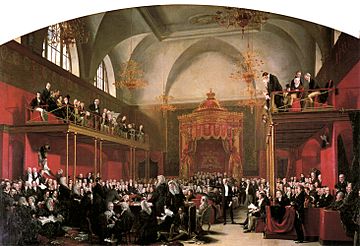
Caroline found that becoming queen made her situation worse. This was because her husband disliked her. When she visited Rome, Pope Pius VII would not meet her. The pope's minister Cardinal Consalvi insisted she be greeted only as a duchess of Brunswick. Not as a queen. To show her rights, she planned to return to Britain. The King demanded that his ministers get rid of her. He successfully convinced them to remove her name from the prayers of the Church of England. But they would not agree to end the marriage. They feared what a public trial would do. Instead of risking a trial, the government talked with Caroline. They offered her more money, £50,000 a year, if she stayed abroad.

By early June 1820, Caroline had traveled north from Italy. She was at St Omer near Calais. She listened to the advice of Alderman Matthew Wood and her lady-in-waiting Lady Anne Hamilton. She refused the government's offer. She said goodbye to Pergami and sailed for England. When she arrived on June 5, riots broke out in her support. Caroline became a symbol for the growing movement that wanted political changes. This movement was against the unpopular king. Still, the King strongly wanted to end their marriage. The next day, he sent evidence gathered by the Milan commission to Parliament. This evidence was in two green bags. On June 15, the guards at the King's Mews rebelled. The rebellion was stopped. But the government feared more trouble. Looking at the evidence was delayed. Parliament debated how to investigate. Finally, on June 27, the bags were opened. Fifteen important members of Parliament looked at them in secret. These members thought the contents were shocking. A week later, after their report, the government introduced a bill. This was the Pains and Penalties Bill 1820. It aimed to take away Caroline's title as queen. It also aimed to end her marriage. It was claimed that Caroline had a close relationship with a man not of noble birth: Bartolomeo Pergami. Many people, like Theodore Majocchi, were called to speak during the bill's reading. This was like a public trial of the Queen. The trial caused a sensation. Details of Caroline's close relationship with Pergami were shared. The bill passed in the House of Lords. But it was not sent to the House of Commons. There was little chance the Commons would pass it.
Even during the trial, the Queen remained very popular. More than 800 petitions and nearly a million signatures supported her. She was a leader for the movement asking for changes. Many revolutionary statements were made in Caroline's name.
But when the trial ended, her link with these groups ended too. The government again offered her £50,000 a year. This time, there were no conditions. Caroline accepted.
On May 5, 1821, Napoleon died. Sir Edmund Nagle told George, "Sir, your bitterest enemy is dead." George replied, "Is she, by God!"
Despite the King's efforts, Caroline remained very popular with the public. She went ahead with plans to attend the coronation service. This was on July 19, 1821, as queen. Lord Liverpool told Caroline she should not go. But she showed up anyway. George had Caroline turned away from the coronation. This happened at the doors of Westminster Abbey. She was refused entry at both the East Cloister and West Cloister doors. Caroline then tried to enter through Westminster Hall. Many guests were gathered there before the service. A witness said the Queen stood at the door, angry. Soldiers held bayonets under her chin. Then the deputy lord chamberlain slammed the doors in her face. Caroline then went back to an entrance near Poets' Corner. There, she met Sir Robert Inglis. He held the office of "Gold Staff." Inglis convinced her to go back to her carriage. She then left. Caroline lost some support because of her actions at the coronation. The crowds booed her as she rode away. Even Brougham said he disliked her undignified behavior.
Death of Caroline
The night after Caroline tried to attend her husband's coronation, she became ill. She took a large dose of milk of magnesia and some drops of laudanum. Over the next three weeks, she felt more and more pain. Her health got worse. She realized she was dying. She put her affairs in order. Her papers, letters, and notebooks were burned. She wrote a new will. She also planned her funeral. She wanted to be buried in her home, Brunswick. Her tomb was to say: "Here lies Caroline, the Injured Queen of England." She died at Brandenburg House in Hammersmith at 10:25 p.m. on August 7, 1821. She was 53 years old. Her doctors thought she had a blockage in her intestines. But she may have had cancer. There were also rumours at the time that she had been poisoned.
Lord Liverpool was afraid that a funeral procession through London would cause public unrest. So, he decided the Queen's funeral procession would avoid the city. It would pass to the north on its way to Harwich and Brunswick. The crowd with the procession was angry. They blocked the planned route with barriers. They wanted to force a new route through Westminster and London. The scene quickly became chaotic. The soldiers guarding the procession fired their guns. They rode through the crowd with their swords drawn. People in the crowd threw stones and bricks at the soldiers. Two people, Richard Honey, a carpenter, and George Francis, a bricklayer, were killed. Finally, Chief Metropolitan Magistrate Sir Robert Baker ordered that the official route be changed. The procession then went through the city. Because of this, Baker was removed from his job.
The final route (in heavy rain) went as follows: Hammersmith, Kensington (blocked), Kensington Gore (blocked), Hyde Park, Park Lane (blocked). Then it returned to Hyde Park. Soldiers forced the gates open. Then Cumberland Gate (blocked), Edgware Road, Tottenham Court Road, Drury Lane, the Strand. From there, it went through the City of London. Then by way of Romford and Chelmsford to Colchester. The coffin stayed overnight at St Peter's Church, Colchester. Caroline's helpers tried to change the official nameplate on the coffin. They wanted it to include "Injured Queen of England." But they were not successful. The next day, the coffin was taken to the seaport of Harwich. It was placed on a ship going to Germany. Brunswick Cathedral is Caroline's final resting place.
Caroline's Legacy
Historian Thomas Laqueur said that the royal dispute interested all Britons. He wrote:
- During much of 1820 the "queen's business" captivated the nation. "It was the only question I have ever known," wrote the radical critic William Hazlitt, "that excited a thorough popular feeling. It struck its roots into the heart of the nation; it took possession of every house or cottage in the kingdom."
In 1822, the publishers of the newspaper John Bull were found guilty. This was for several false statements published during the Queen's life. One statement called her "a shameless woman." It was claimed these statements had made the Queen bitter and shortened her life.
The story of Caroline's marriage to George has been shown in films and plays. It was the basis for the 1996 BBC docudrama A Royal Scandal. Susan Lynch played Caroline, and Richard E. Grant played George IV. The 2008 radio play The People's Princess also told her story. Alex Jennings played George IV and Rebecca Saire played Caroline. This play showed similarities to the marriage and divorce of Charles, Prince of Wales (later Charles III), and Diana, Princess of Wales. Caroline is also the subject of Richard Condon's 1977 novel The Abandoned Woman.
Royal Symbols
Caroline's royal symbols, called coat of arms, combine her husband's and her father's symbols. Her father's symbols were for the Duke of Brunswick. The symbols were divided into twelve parts. The first part showed a gold shield with red hearts and a blue lion. This was for Lüneburg. The second part showed a red shield with two gold lions. This was for Brunswick. The third part showed a blue shield with a silver lion wearing a gold crown. This was for Eberstein. The fourth part showed a red shield with a gold lion. It had a border of silver and blue squares. This was for Homburg. The fifth part showed a gold shield with a red lion wearing a blue crown. This was for Diepholz. The sixth part showed a red shield with a gold lion. This was for Lauterberg. The seventh part was divided horizontally. The top part was gold with two black bear paws. This was for Hoya. The bottom part had silver and blue triangles. This was for Old Bruckhausen. The eighth part showed a blue shield with a silver eagle. This was for the Diepholz eagle. The ninth part had a checkerboard pattern of silver and red. This was for Hohnstein. The tenth part showed a silver shield with a red deer antler pointing diagonally. This was for Regenstein. The eleventh part showed a silver shield with a black deer walking. This was for Klettenberg. The twelfth part showed a silver shield with a black deer antler pointing diagonally to the left. This was for Blankenburg.
As Princess of Wales, she used her husband's symbols. These were the royal arms with a three-pointed silver label. These were combined with her father's symbols. The whole design had a crown for the heir to the throne.
Children
| Name | Born | Died | Notes |
|---|---|---|---|
| Princess Charlotte of Wales | January 7, 1796 | November 6, 1817 | married in 1816 to Prince Leopold George Frederick of Saxe-Coburg-Saalfield; no children survived |
See also
 In Spanish: Carolina de Brunswick-Wolfenbüttel para niños
In Spanish: Carolina de Brunswick-Wolfenbüttel para niños


